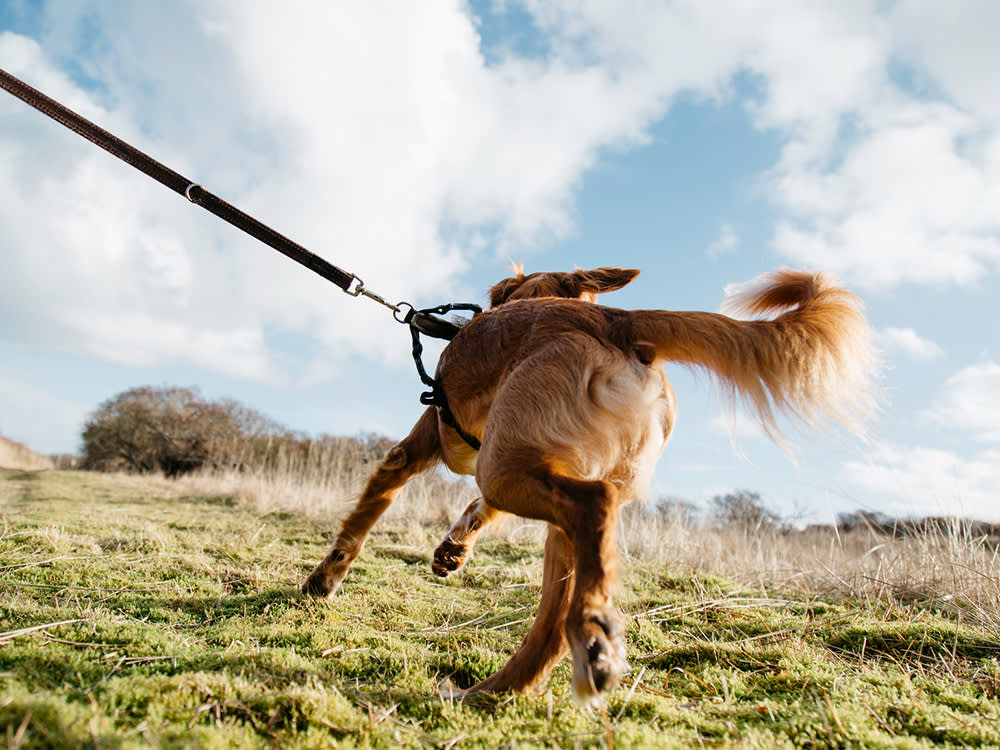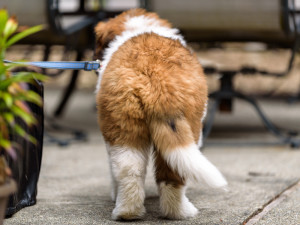Does Your Dog Have Happy Tail Syndrome?
If your pup's exuberant tail wagging has led to injury, they could have this condition.
Happy tail syndrome is a bit of a misnomer. This frustrating problem makes both dogs and people decidedly unhappy. What is happy tail syndrome, exactly? It occurs when a dog wags their tail forcefully, hitting objects (like walls, chairs, even people), and injures themself in the process. The good news is you can keep happy tail syndrome from escalating if you catch it early. Here ’ s everything you need to know, including how to treat happy tail syndrome if you think your dog already has it.
What Is Happy Tail Syndrome?
We love to see our dogs happy — floppy tongues, wiggle bottoms, and tails wagging — but for some dogs, these overjoyed moments result in excessive wagging, with the dog’s tail whacking so hard that the tip gets injured in the process. The repeated slaps of the tail in contact with walls, doorways, and other hard surfaces result in an open wound. In some cases, the tail damage may even include broken vertebrae or damaged tendons.
Snap a pic of your pup’s teeth, and GREENIES™ will help you spot potential signs of oral health issues.
Sometimes referred to as “kennel tail” and “bleeding tail,” happy tail syndrome should not be confused with “limber tail syndrome,” another condition associated with an injured tail. Happy tail syndrome is more often seen in large, short-haired dogs with muscular tails like Labrador Retrievers, Pit Bulls, Great Danes, Greyhounds, Dobermans, and similar breeds.
How is Happy Tail Syndrome Treated?
Happy tail syndrome is difficult for vets to treat. The tip of the tail where injuries most often occur is, as Dr. Tony Johnson of the Veterinary Information Networkopens in new tab, says, “an amazingly difficult” spot to bandage — it tends to fall off easily. Dogs with happy tail syndrome are likely over-exuberant, excitable tail waggers — regardless of the pain they are experiencing — which makes it almost impossible to keep the wound covered and clean. Because of this, happy tail syndrome is often a recurring challenge.
How much do you spend on your pet per year?
Happy tail syndrome rapidly escalates, so if you see raw, reddened, or irritated tail skin, contact your vet to discuss the situation before it bleeds and worsens. As a first step, your vet will likely recommend that the wound be cleaned and wrapped in a bandage. A soft recovery collar (cone) will be helpful to keep your dog from licking or pulling off the bandage. If you’re unable to manage treatment at home or the bandages just won’t stay put, ask your vet about other options. You may need to get creative with keeping the wound clean and wrapped — some vets have used pool noodles and different types of padding to get the job done. Your dog may also need minor stitching, K-laser treatments, or even surgical amputation, if the happy tail worsens.
Happy tail syndrome is messy and complicated. While you can’t bubblewrap the whole house, you can keep a vigilant eye out for this problem. And with a bit of patience and love, you can keep enjoying your pup ’ s goofy tail wags — safely.








